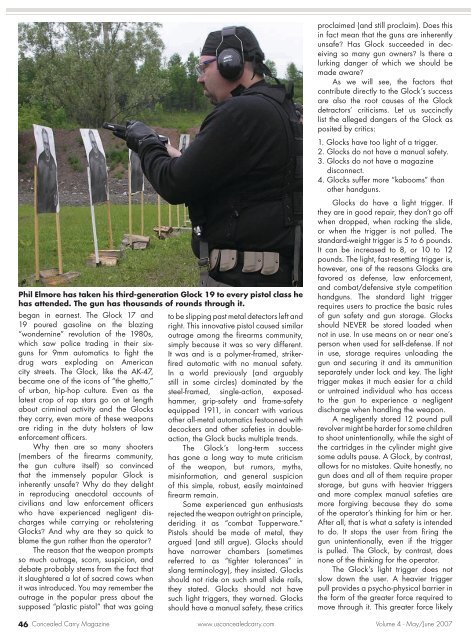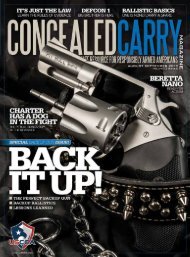You also want an ePaper? Increase the reach of your titles
YUMPU automatically turns print PDFs into web optimized ePapers that Google loves.
Phil Elmore has taken his third-generation Glock 19 to every pistol class hehas attended. The gun has thousands of rounds through it.began in earnest. The Glock 17 and19 poured gasoline on the blazing“wondernine” revolution of the 1980s,which saw police trading in their sixgunsfor 9mm automatics to fight thedrug wars exploding on Americancity streets. The Glock, like the AK-47,became one of the icons of “the ghetto,”of urban, hip-hop culture. Even as thelatest crop of rap stars go on at lengthabout criminal activity and the Glocksthey carry, even more of these weaponsare riding in the duty holsters of lawenforcement officers.Why then are so many shooters(members of the firearms community,the gun culture itself) so convincedthat the immensely popular Glock isinherently unsafe? Why do they delightin reproducing anecdotal accounts ofcivilians and law enforcement officerswho have experienced negligent dischargeswhile carrying or reholsteringGlocks? And why are they so quick toblame the gun rather than the operator?The reason that the weapon promptsso much outrage, scorn, suspicion, anddebate probably stems from the fact thatit slaughtered a lot of sacred cows whenit was introduced. You may remember theoutrage in the popular press about thesupposed “plastic pistol” that was goingto be slipping past metal detectors left andright. <strong>This</strong> innovative pistol caused similaroutrage among the firearms community,simply because it was so very different.It was and is a polymer-framed, strikerfiredautomatic with no manual safety.In a world previously (and arguablystill in some circles) dominated by thesteel-framed, single-action, exposedhammer,grip-safety and frame-safetyequipped 1911, in concert with variousother all-metal automatics festooned withdecockers and other safeties in doubleaction,the Glock bucks multiple trends.The Glock’s long-term successhas gone a long way to mute criticismof the weapon, but rumors, myths,misinformation, and general suspicionof this simple, robust, easily maintainedfirearm remain.Some experienced gun enthusiastsrejected the weapon outright on principle,deriding it as “combat Tupperware.”Pistols should be made of metal, theyargued (and still argue). Glocks shouldhave narrower chambers (sometimesreferred to as “tighter tolerances” inslang terminology), they insisted. Glocksshould not ride on such small slide rails,they stated. Glocks should not havesuch light triggers, they warned. Glocksshould have a manual safety, these criticsproclaimed (and still proclaim). Does thisin fact mean that the guns are inherentlyunsafe? Has Glock succeeded in deceivingso many gun owners? Is there alurking danger of which we should bemade aware?As we will see, the factors thatcontribute directly to the Glock’s successare also the root causes of the Glockdetractors’ criticisms. Let us succinctlylist the alleged dangers of the Glock asposited by critics:1. Glocks have too light of a trigger.2. Glocks do not have a manual safety.3. Glocks do not have a magazinedisconnect.4. Glocks suffer more “kabooms” thanother handguns.Glocks do have a light trigger. Ifthey are in good repair, they don’t go offwhen dropped, when racking the slide,or when the trigger is not pulled. Thestandard-weight trigger is 5 to 6 pounds.It can be increased to 8, or 10 to 12pounds. The light, fast-resetting trigger is,however, one of the reasons Glocks arefavored as defense, law enforcement,and combat/defensive style competitionhandguns. The standard light triggerrequires users to practice the basic rulesof gun safety and gun storage. Glocksshould NEVER be stored loaded whennot in use. In use means on or near one’sperson when used for self-defense. If notin use, storage requires unloading thegun and securing it and its ammunitionseparately under lock and key. The lighttrigger makes it much easier for a childor untrained individual who has accessto the gun to experience a negligentdischarge when handling the weapon.A negligently stored 12 pound pullrevolver might be harder for some childrento shoot unintentionally, while the sight ofthe cartridges in the cylinder might givesome adults pause. A Glock, by contrast,allows for no mistakes. Quite honestly, nogun does and all of them require properstorage, but guns with heavier triggersand more complex manual safeties aremore forgiving because they do someof the operator’s thinking for him or her.After all, that is what a safety is intendedto do. It stops the user from firing thegun unintentionally, even if the triggeris pulled. The Glock, by contrast, doesnone of the thinking for the operator.The Glock’s light trigger does notslow down the user. A heavier triggerpull provides a psycho-physical barrier inthe form of the greater force required tomove through it. <strong>This</strong> greater force likely46 <strong>Concealed</strong> <strong>Carry</strong> Magazine www.usconcealedcarry.comVolume 4 - May/June 2007
















